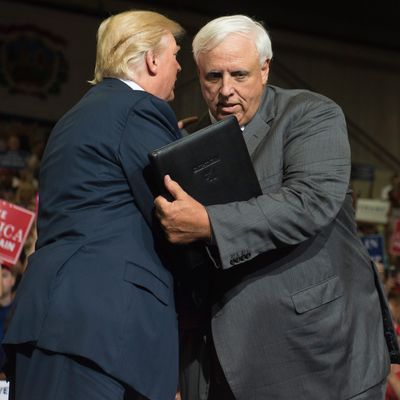
The defection of West Virginia governor Jim Justice yesterday from the Democratic to the Republican Party will inevitably fuel tired rhetoric about Reagan Democrats, or white working-class Americans, or “heartland voters,” leaving the Donkey Party in hordes in protest against its radical bicoastal liberalism. Democrats obviously need to pay attention to voters they’ve recently lost or failed to energize, all over the place, and in various demographic categories.
But the “Trump Democrat” phenomenon may have been a bit oversold. Justice obviously was never much of a Democrat to begin with. And the broader category of “Obama-Trump voters” — those who voted for Barack Obama in 2008 or 2012, and then for the mogul in 2016 — may have been misunderstood as well. Or so reports the Washington Post’s Dana Milbank:
[N]ew data, and an analysis by AFL-CIO political director Michael Podhorzer that he shared with me, puts all this into question. The number of Obama-to-Trump voters turns out to be smaller than thought. And those Obama voters who did switch to Trump were largely Republican voters to start with. The aberration wasn’t their votes for Trump but their votes for Obama.
One problem with the much-discussed idea that Obama-Trump voters swung the election is that voters notoriously overreport votes for the election winner after the election. So some Obama-Trump voters didn’t actually vote for Obama, and others didn’t actually vote for Trump. (Some may have even voted for everyone other than Obama and Trump). That reduces the magnitude of the “flip.”
To the extent that Obama-Trump voters were identified as those who voted for the 44th president in either 2008 or 2012, it is important to remember that Obama won pretty big the first time around: According to exit polls, he won 9 percent of self-identified Republicans and 20 percent of self-identified conservatives. He also won independents — a category that includes a lot of people who usually vote Republican — 52/44.
But there’s more than incidental evidence that apparent Obama-Trump voters aren’t loyal Democrats who suddenly flipped because Trump was appealing to their material or cultural interests: They supported Republicans down-ballot, too:
The AFL-CIO’s Podhorzer analyzed raw data from the Cooperative Congressional Election Study, out in the spring, and found that Obama-Trump voters voted for Republican congressional candidates by a 31-point margin, Republican Senate candidates by a 15-point margin and Republican gubernatorial candidates by a 27-point margin. Their views on immigration and Obamacare also put them solidly in the GOP camp.
If these voters have been “lost” by the Democratic Party, many of them are probably lost for good.
Milbank concludes: “The party would do better to go after disaffected Democrats who didn’t vote in 2016 or who voted for third parties.” A vote’s a vote, and in a competitive environment it makes no sense for Democrats to write anyone off. But the obsession with “Obama-Trump voters” may be myopic.






























